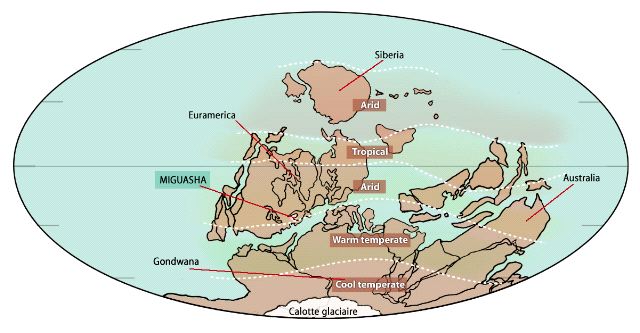Climate

 (56 kb)But the end of the Devonian was marked by a period of global cooling, and severe glaciations caused the extinction of many species. This cooler period lasted for 100 million years until the beginning of the Triassic Period, when dinosaurs rose up to reign over the world.
(56 kb)But the end of the Devonian was marked by a period of global cooling, and severe glaciations caused the extinction of many species. This cooler period lasted for 100 million years until the beginning of the Triassic Period, when dinosaurs rose up to reign over the world.The cooling episode may be partly explained by the emergence of photosynthetic plants in Earth’s first forests. Photosynthetic plants remove carbon dioxide – a greenhouse gas – from the atmosphere, and this may have contributed to the lower temperatures. But the “big chill” can also be explained by the positions of the continents themselves. With the major remodelling of a landmass like that involved in the formation of Pangea, oceans are closed and water currents drastically modified.

 (40 kb)Ocean currents are important temperature regulators because they redistribute heat around the planet, so a change in ocean current circulation inevitably leads to a change in the climate.
(40 kb)Ocean currents are important temperature regulators because they redistribute heat around the planet, so a change in ocean current circulation inevitably leads to a change in the climate.
Title: Atmospheric carbon curve
Author: François Bienvenue
Sources: Parc national de Miguasha
Year: 2007
Description:
Variations in temperatures and atmospheric concentrations of carbon through geological time. A marked drop in the concentration of atmospheric carbon and rapid cooling characterized the end of the Devonian and the onset of the Carboniferous.

Title: Miguasha under the tropics!
Author: François Bienvenue
Sources: C.R. Scotese (Paleomap Project, http://scotese.com).
Year: 2007
Description:
Major climatic domains of the Upper Devonian. The region of Miguasha was situated south of the equator and benefited from a relatively warm climate. An ice cap associated with an overall decrease in temperatures formed at the South Pole at the end of the Devonian. Position of the paleocontinents by C.R. Scotese (Paleomap Project, http://scotese.com).


